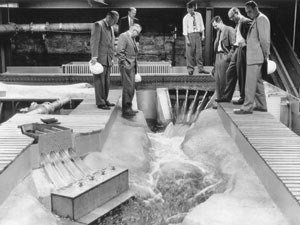Fluid dynamics research helps world

SAFL's rich legacy inspired future solutions for a wide range of world challenges and concerns
TUCKED AWAY ON AN ISLAND in the Mississippi River, a mile from campus, University scientists and engineers have been developing innovative solutions to the world's water and energy-related problems for more than 70 years.
Researchers at the St. Anthony Falls Laboratory (SAFL) apply their expertise in fluid dynamics to a wide range of concerns, such as optimizing renewable energy resources, restoring rivers and deltas, investigating impacts of climate change on lakes and streams, and improving designs for life-saving medical devices.
Visionary beginnings
While the University first explored developing a civil engineering hydraulic laboratory at St. Anthony Falls in 1908, it was not seriously pursued until the early 1930s. Their interest was sparked by Lorenz G. Straub, who came to the University in the fall of 1930 inspired by the hydraulic laboratories he studied in Germany. He envisioned a University-based institute that would not only serve as a place of education, but simultaneously pioneer new methods in water resources management.
Straub’s vision became reality when President Franklin Roosevelt established the Works Progress Administration in 1935, enabling the University to begin constructing the lab on Hennepin Island the next year.
Completed in 1938, the lab was built to enable researchers to use the river’s natural 50-foot drop at the falls to route water to experimental models throughout the building. Straub became the first director of the St. Anthony Falls Hydraulic Laboratory.
Since its inception, SAFL has attracted researchers from all over the world who come to conduct research in its unique experimental facilities. Hundreds of undergraduate and graduate students, visiting scholars, and postdoctoral fellows have collaborated and conducted studies, enriching the fields of environmental fluid mechanics and water resources on an international level.
Pioneering sustainable water resources management
Engineers at SAFL have contributed to some of the world’s largest hydropower and irrigation projects of the last century, such as Mangla Dam in West Pakistan and Guri Dam in Venezuela.
Between 1963 and 1977, under the leadership of former directors Edward Silberman, Alvin Anderson, and John Ripken, SAFL’s strengths lay in the areas of hydraulics, stratified flows, turbulence, and hydrology. The lab also aimed to intensify an already robust naval hydrodynamics research program, and did so by recruiting a leader in this field, Professor Roger Arndt, as SAFL’s fifth director.
Although research in hydraulic and river engineering continued throughout the following decades, Arndt’s tenure (1977-1993) emphasized integrating education with basic and applied research. Under his leadership, laboratory research expanded into new areas, such as computational fluid dynamics, cavitation, and wind engineering.
A Place to Call Home
From 1993 to 2005, led by directors Gary Parker and Efi Foufoula-Georgiou, and as environmental concerns took center stage, SAFL remained a pioneer, adding new faculty with expertise in the areas of sedimentary geology, eco-biological fluid dynamics, and atmospheric boundary layers. The word “Hydraulic” was dropped from the lab’s name and SAFHL became SAFL in 1995; the following year the Department of Geology and Geophysics was added as the second affiliated department.
Decade-long efforts to broaden the lab’s focus of emphasizing collaborative research in environmental, geophysical, and biological fluid mechanics led to establishing the National Center for Earth Surface Dynamics (NCED) in 2002. A National Science Foundation-sponsored Science and Technology Center, NCED’s vision to transform the management of ecosystems, water resources, and land use was a natural extension of SAFL’s interdisciplinary character and marked a new era for the laboratory. A growing emphasis on problems at the intersection of fluid mechanics and ecology led SAFL to add Ecology, Evolution, and Behavior as its third affiliated department in 2005.
Research in the energy-environment nexus
The laboratory, currently led by director Fotis Sotiropoulos, is continuing its expansion into new research areas in the energy-environment nexus. In 2008, SAFL and NCED jointly established the Outdoor StreamLab, a one-of-a-kind experimental facility for stream restoration which attracts students and scientists worldwide. In 2009, the U.S. Department of Energy awarded a SAFL-led industry/academe consortium a major grant to conduct research aimed at helping the U.S. achieve its goal of 20 percent wind power by 2030. Along with other new programs in hydrokinetic power and algal-based biofuels, this grant has helped to establish SAFL as a national leader in renewable energy research and a major hub for collaborations between academia and industry.
“Today SAFL continues to serve Straub’s vision by emphasizing academic excellence and research scholarship, while staying at the cutting-edge of fluid mechanics research,” Sotiropoulos said. “We are inspired by our rich legacy as we move forward to tackle the major sustainability challenges of our time, adding new pages to the history of this unique research facility.”
